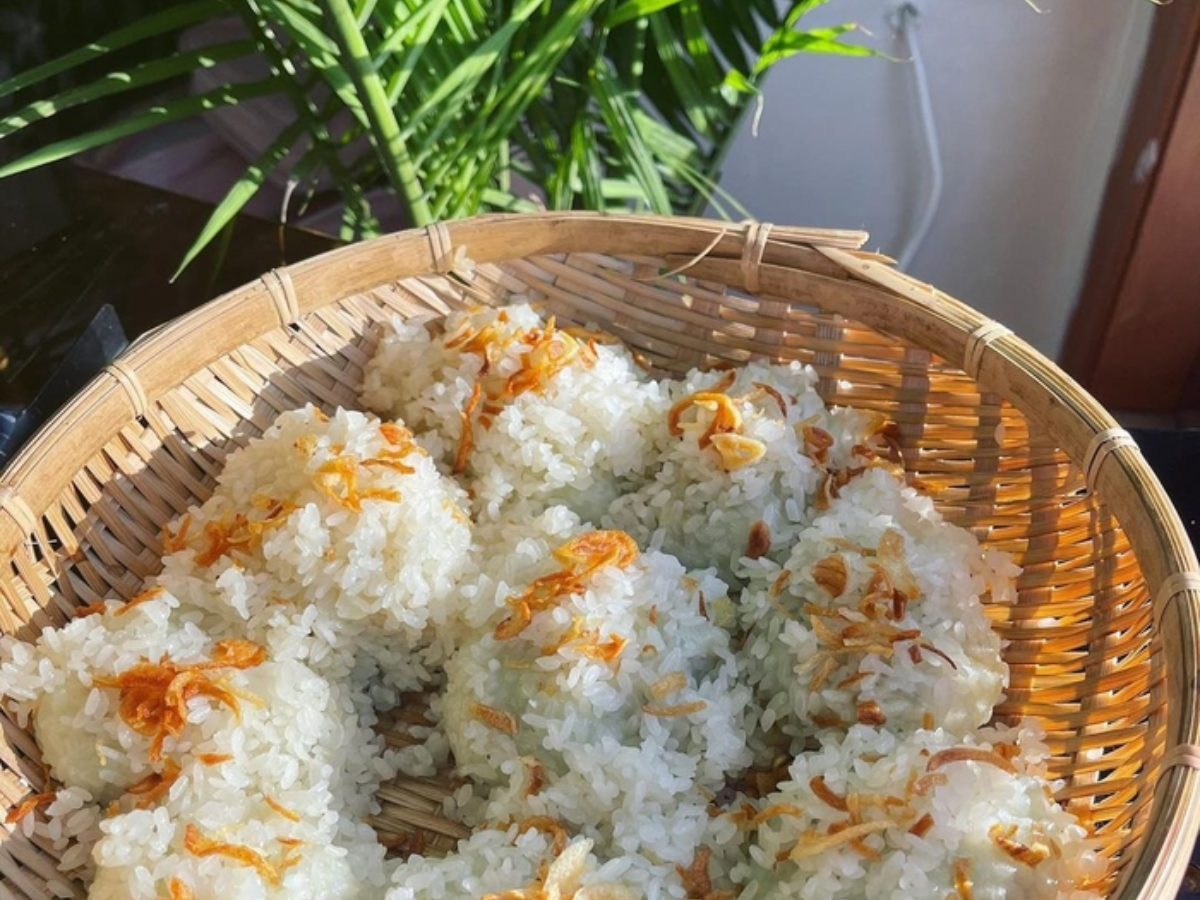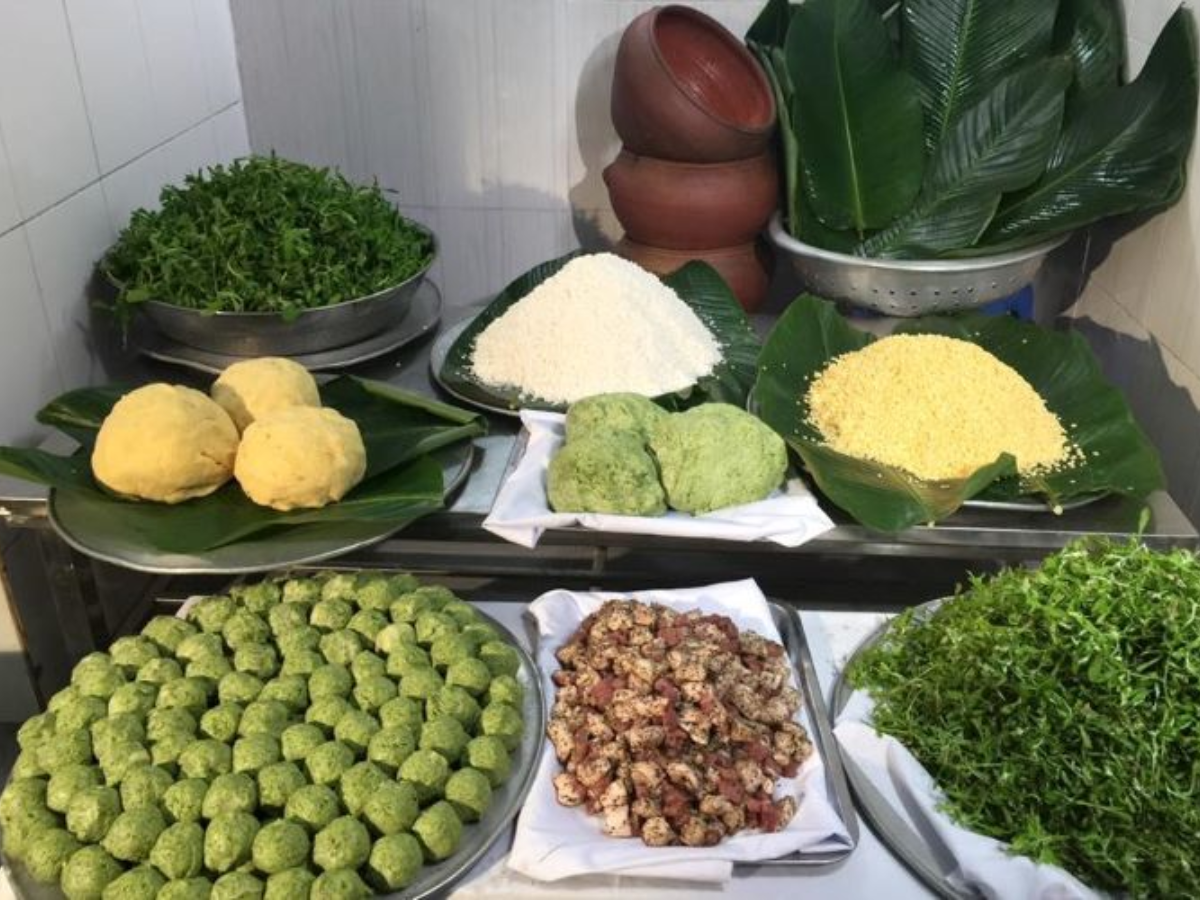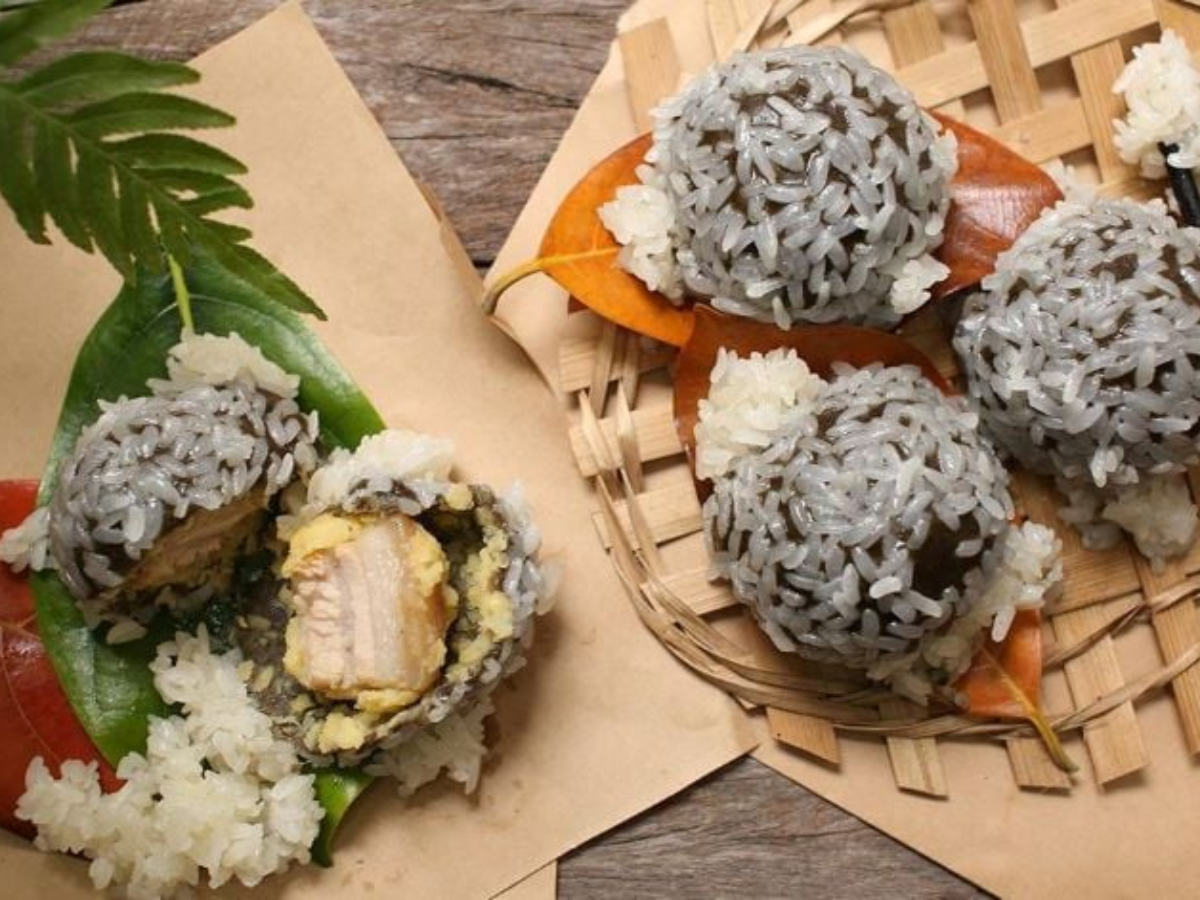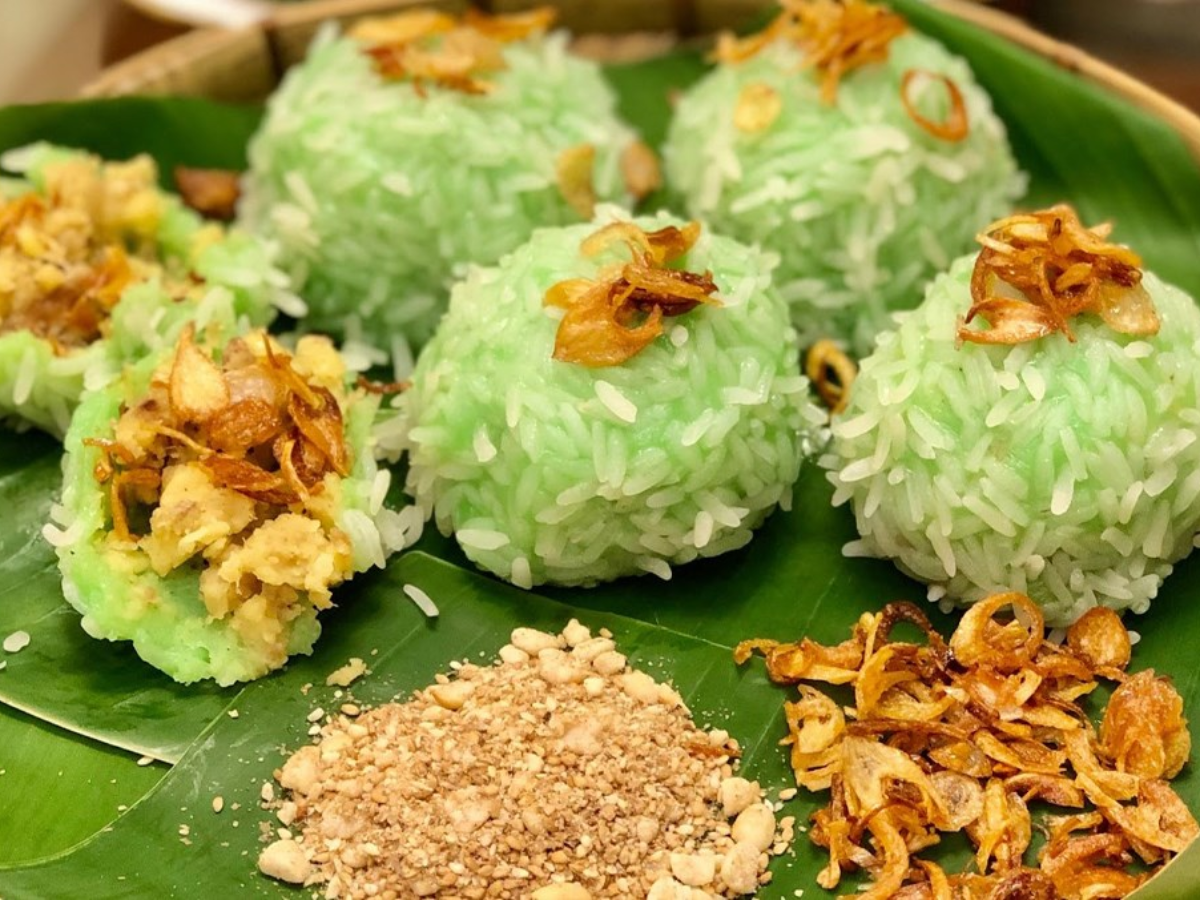1. Overview of Hai Phong Xoi Khuc
1.1. What is Hai Phong Xoi Khuc?
Hai Phong Xoi Khuc is a dish with the distinct characteristics of the cuisine of the Port land, notable for its light green color from fresh Khuc leaves mixed into the sticky rice. The filling inside consists of finely ground mung beans, minced pork belly stir-fried with fried shallots, and a hint of Northern pepper, creating a unique aroma.
Unlike Xoi Khuc in other regions, Hai Phong Xoi Khuc typically has more fatty pork, offering a pleasant richness without being greasy. The glutinous rice wrapper is moderately chewy, and the mung bean filling mixed with pork highlights a savory taste, providing a harmonious balance when enjoyed. Locals often choose this dish for breakfast, as a midday snack, or as a gift from their hometown, due to its palatable taste and rich nutrition.

Xoi Khuc specialty of Hai Phong. (Source: Collected)
1.2. History and cultural significance of Hai Phong Xoi Khuc
For many generations of Hai Phong people, Hai Phong Xoi Khuc is a dish associated with childhood memories. This is not only a simple rustic gift but also expresses the simplicity and authenticity of the Northern Delta region, where people cherish every grain of sticky rice and every knotweed leaf they picked themselves.
Xoi Khuc often appears during festivals, Tet holidays, community events, as well as in daily life. This dish is a symbol of family bonding, neighborly affection, and the awareness of preserving traditional values. Each Hai Phong Xoi Khuc demonstrates sophistication in ingredient selection and preparation, reflecting the carefulness and meticulousness of the cook, as well as contributing to preserving the local culinary heritage through generations.
2. The secret to making authentic Hai Phong Xoi Khuc
2.1. The "soul" ingredients of Hai Phong Xoi Khuc
To create a perfectly flavored Hai Phong Xoi Khuc, the ingredient selection process is extremely important. Cai Hoa Vang sticky rice from Dai Thang, Tien Lang, Hai Phong is favored for its soft chewiness and natural aroma. When cooked, the sticky rice grains achieve a chewy texture, neither mushy nor hard.
Hai Phong knotweed leaves, also known as wild knotweed, are the ingredient that creates a gentle green color and brings a unique aroma to the dish. Using local knotweed leaves helps maintain a distinctive flavor not found elsewhere. The chosen mung beans must be firm grains, soaked until soft, then cooked and mashed, providing a mild, nutty taste.
The filling is a combination of finely chopped pork belly or lean pork fat, stir-fried until firm with fried shallots and Northern pepper. Thanks to this, the filling is both rich and not greasy. Seasonings such as Northern pepper, fragrant fried dried onions, and fish sauce contribute to enhancing the savory flavor, creating a complete flavor profile for the Hai Phong Xoi Khuc dish.

The "soul" ingredient of Xoi Khuc Hai Phong. (Source: Collected)
2.2. Process of making Xoi Khuc Hai Phong from A to Z
The processing steps of Xoi Khuc Hai Phong require meticulousness and skill. Khuc leaves, after harvesting, are washed, boiled, then pureed or pounded, and mixed with glutinous rice flour to create a smooth green outer layer. In cases where fresh leaves are unavailable, dried leaves can be used while still ensuring the original aroma.
The filling process requires certain techniques. Mung beans are soaked until soft, cooked, then mashed. Pork belly is finely chopped, marinated with pepper and dried shallots, and stir-fried until firm. Then, the mung bean paste is rolled into balls, the meat filling is wrapped around the center, forming evenly round fillings.
When shaping, the dough made from khuc leaves is flattened, the filling ball is placed in the center and rolled into a ball, rolled in soaked glutinous rice, then wrapped in dong leaves or banana leaves. The cakes are arranged in a steamer and steamed for about 15 to 20 minutes, depending on the thickness of the rice layer. When cooked, xoi khúc achieves a moderate chewiness, fragrant with khuc leaves and a rich filling. To maintain the natural green color, khuc leaves need to be processed immediately after picking, limiting exposure to the air for too long.

Xoi khuc is shaped into small, bite-sized pieces. (Source: Collected)
2.3. New variations in 2026
2026 saw the emergence of many attractive variations for Hai Phong xoi khuc. Some places add shredded coconut or coconut milk to enhance the mild richness, aligning with modern nutritional trends. As a result, the xoi khuc dish becomes rich and appealing to young people.
Some eateries also use pandan leaves or sticky rice leaves to enhance the green color and bring a fresh aroma. This creativity helps Hai Phong xoi khuc better suit the tastes of young customers and international tourists. Additionally, adjusting the ratio of green bean filling to be more abundant and reducing the fat content in the meat is also applied in some places, creating a lighter dish that aligns with healthy eating trends.
3. Suggestions for famous delicious Hai Phong xoi khuc eateries
3.1. Top Hai Phong xoi khuc eateries to try when visiting the Port City
Ba Sai Xoi Khuc at Cot Den Market, located at 28A Cau Dat, Gia Vien ward, Hai Phong, is known for its sticky glutinous rice, fluffy green bean filling, and perfectly balanced fatty pork belly. The flavor of the kuc leaf adheres to the traditional standard thanks to a secret family recipe. The eatery is open in the morning from 6:00 AM to 10:00 AM, with reasonable prices and dedicated service.
Trang Cao Xoi Xeo, located at 142 Hoang Minh Thao, Du Hang Kenh ward, Le Chan district, Hai Phong City, impresses with its secret family recipe combining yellow flower sticky rice, savory green beans, and rich braised meat. The eatery serves attentively from 5:30 AM to 10:30 AM daily and attracts a large number of customers thanks to its complete and balanced flavor.
Xoi Man Cot Den, located at 5B/172 Dinh Dong, Dong Hai ward, Le Chan District, Hai Phong City, carefully selects rice grains, offering soft and chewy xoi khuc with many topping options such as meat, pate, sausage, and fried eggs. The eatery emphasizes food safety and hygiene, and the service staff is always friendly. Each of the above addresses excels in the chewiness of xoi khuc, the authentic kuc leaf flavor, friendly service, and suitable prices.
3.2. Hai Phong xoi khuc eateries developing in major cities and abroad
In Hanoi and Ho Chi Minh City, many small xoi khuc eateries opened by Hai Phong natives have preserved the traditional preparation methods. Some places also add shredded coconut or pandan leaves to make Hai Phong xoi khuc more suitable for the tastes of city diners. These eateries maintain stable quality, with modern and clean dining spaces.

Xoi Khuc with an eye-catching green color made from pandan leaves. (Source: Collected)
4. Suggestions for travel experiences combined with Xoi Khuc of Hai Phong (Coastal City)
A day in Hai Phong (Coastal City) will be more interesting if you start by enjoying Xoi Khuc of Hai Phong (Coastal City) at famous eateries like Cot Den Market (Lighthouse Market) or Ba Sai's shop. The distinctive flavor of the dish helps you deeply feel the culinary spirit of this land. After that, the journey should continue with visits to traditional markets, where you can learn about the buying and selling culture and meet hospitable locals.
Stopping by a Hai Phong (Coastal City) cafe near Xoi Khuc eateries is also a way to enjoy a relaxing space in the heart of the city. You can continue your trip with destinations like Tam Bac Lake, Bach Dang Giang, or experience the Sun World Cat Ba cable car to combine the appreciation of nature, culture, and the city's modern cuisine.

Experience the cable car with panoramic views of Cat Ba. (Source: Collected)
For a more complete experience, don't forget to try Hai Phong crab noodle soup with rich freshwater crab meat, crispy spicy baguette filled with fragrant pate, or enjoy a cool glass of Thai sweet soup. These dishes will enrich your culinary exploration journey and leave an unforgettable aftertaste in the hearts of every tourist.
Hai Phong sticky rice with filling is not only a specialty of local cuisine but also a symbol of homeland spirit, contributing to conveying the simplicity and warmth of the people of the Port City. Each layer of fragrant, chewy sticky rice is a blend of tradition and creativity, offering diners a complete and profound experience. When you set foot in the city of red phoenix flowers, don't forget to enjoy sticky rice with filling and share your own feelings about that beloved flavor.



